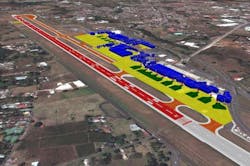GE Aviation customers gain access to GeoEye 3D airport maps, earth imagery, digital terrain and obstacle data
GE will provide ICAO Annex 15 Area-2 terrain and obstacle databases to support the development of new performance-based navigation (PBN) flight paths around the world. GeoEye’s digital, detailed terrain and obstacle mapping collected by high-resolution commercial earth-imaging satellites will support airports, airlines, and aviation authorities as they adopt PBN.
“This advanced aeronautical data, along with our Required Navigation Performance (RNP) products, will accelerate the deployment of RNP flight paths that will help meet the global challenge of increasing efficiency in the world's air traffic management system,” explains Giovanni Spitale, general manager of GE’s PBN Services. “It will allow the benefits of PBN to be achieved earlier for the global air transportation community--saving time and fuel, reducing emissions and noise, while increasing hourly operations frequency and maintaining safety.”
Additional GE Aviation offerings under the agreement will support advanced terrain and obstacle visualization, surface guidance through airport mapping databases (AMDB), pilot simulator training, and flight operations quality assurance (FOQA) replay.
“Over the next decade, we will eventually provide this aeronautical data for hundreds of airports in the world,” Spitale adds. “This will become the reference geospatial database for the aviation community.”
